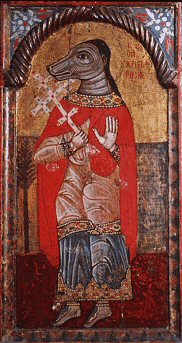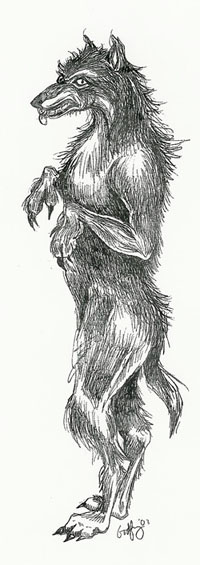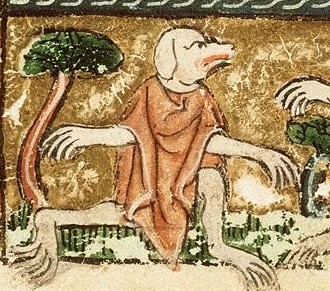Who Were The Dogheads?
Posted by: Loren Coleman on November 22nd, 2006
Click on the above image of a doghead to make it grow larger.
Dogheads were more than mythological creatures, according to some ancient sources. One of them even became a Saint, as per:

Who were the dogheads? What is cynocephaly all about?
Wikipedia (not a source that should be the only one a person ever uses), in discussing cynocephaly, has this piece of modern trivia: “In the USA there are tales of dog-headed creatures, including the Dogman of Michigan, and the wolf-like Beast of Bray Road of Wisconsin, which terrorized a neighbourhood in the early 1990s.”

Maybe Linda Godfrey is on to something? For more discussions of contemporary American cynocephaly, see The Beast of Bray Road and Hunting the American Werewolf.
About Loren Coleman
Loren Coleman is one of the world’s leading cryptozoologists, some say “the” leading living cryptozoologist. Certainly, he is acknowledged as the current living American researcher and writer who has most popularized cryptozoology in the late 20th and early 21st centuries.
Starting his fieldwork and investigations in 1960, after traveling and trekking extensively in pursuit of cryptozoological mysteries, Coleman began writing to share his experiences in 1969. An honorary member of Ivan T. Sanderson’s Society for the Investigation of the Unexplained in the 1970s, Coleman has been bestowed with similar honorary memberships of the North Idaho College Cryptozoology Club in 1983, and in subsequent years, that of the British Columbia Scientific Cryptozoology Club, CryptoSafari International, and other international organizations. He was also a Life Member and Benefactor of the International Society of Cryptozoology (now-defunct).
Loren Coleman’s daily blog, as a member of the Cryptomundo Team, served as an ongoing avenue of communication for the ever-growing body of cryptozoo news from 2005 through 2013. He returned as an infrequent contributor beginning Halloween week of 2015.
Coleman is the founder in 2003, and current director of the International Cryptozoology Museum in Portland, Maine.











Interesting subject that I definitely never thought about. I never realized that there were a complete group thought to have a dog’s face. Could they have possible had the werewolf disorder? It would be enough to scare ancient people. I guess the main thing is that such ideas do go against everything I was taught, but then again my teachings were totally western/european/judeo/christian and american in nature, so there are so many things that we have no idea what is true and what isn’t. There are some people I’ve heard about that worship a spirit (they say the spirit of certain animals) that when they allow the spirit to take control they become the closest thing to a were… (place the name of the animal at the dots). Even seen footage of someone becoming a wereleopard. Grant you he didn’t transform physically, but he did act very cat-like, even doing things physically impossible for humans.
For years I tried to find more info on the cynocephalics. I heard a legend once that Caesar had an entire unit of them in his army.
I could never turn up anything substantial in any of the historic records, though.
One of them became a saint, but that’s not all
In Ancient Egypt there was a god with the head of a jackal or dog, namely Anubis or Anpu.
So these stories go way back. Could that possibly be the origin of these creatures, the stories I mean?
Jojo the dog faced boy and others through out history have suffered with a profusion of hair over whole bodies, it is a disorder. To the mind of the middle ages the individual may have been thought to have been thought part dog.
Hypertrichosis notwithstanding, cynocephaly is an almost entirely different disorder affecting the facial and cranial structures. Besides being a medical condition provoking s sincere amount of interest, (no cases reported for many years, however) the cryptozoological ramifications are mind boggling. Where we have legends of wolfmen, and the were-folk, they could readily be rationalized by this incredibly rare disorder. It gives me greater and greater hope to know that mainstream science and our cryptozoological interests are ever increasingly crossing paths on a regular basis.
By the way, shumway, any chance you could link us to your wereleopard footage? Thought I’d ask, lol. Happy Thanksgiving, all.
Actual were transformation footage? Hahaha, that is all. Seriously though, I doubt that lycanthropes actually exist. I had an argument with a were-obsessed fellow before on the matter.
Interesting stuff. A lot of legends and myths are originally based on some grain of truth, so I wonder what the story is on these dog faced people. They are prominent in a lot of cultures, such as medieval Europe and as Riptor said, the anubis in ancient Egypt. Was it a genetic disorder that frightened the people of the time? Was it real cryptid animals of some sort? Was it some kind of deformity that certain individuals displayed, such as the elephant man had? I agree with Lordofshades that it is fascinating to see mainstream science and cryptozoology cross paths.
Mystery_Man, dogheads are prominent in many cultures over many continents, but I have to say something.
Speaking about Ancient Egypt, because that’s what I’m most familiar with, if it was indeed a disease that scared people, why would they believe in a god that suffered from that disorder?
Although Anubis was associated with death and the underworld, he was still very much worshipped and was a vital part of the burying cerimonies of the pharaos.
So the question is: If it’s a disease, why worship a god that suffers from that?
If it was a cryptid, why would they make it into a god? And, in contrast with the images presented here, why is only the head that of a dog or jackal, while the body remains human?
The leopard society in Africa is a secret society where the members would partake of a hallucigent and dress in leopard skins and wear manufactured claws. The transformation is drug induced mental state, not physical. Rather like reports of the ointment suppied by the devil to be rubbed on the body to transform into a werewolf. The members of the leopord society would do this in times of community strife, when no other means have brought about an end to the communtiy disagreement. The leopardmen would attack indiscrimanately, and the community would come to an agreement more quickly in the face of this terror, and once an agreement was reached, the attacks would stop.
This may well be a cryptid story, but even if it is, it’s also probably become entangled with at least two other subjects: the first, pretty much covered by the reference to Saint Christopher, is Astronomy, because to me, the tale of the dog-headed Saint Christopher supporting the Christ Child alludes to the constellation Canis Major appearing to be supporting the constellation Orion in the sky; whilst the other influence seems to be a certain esoteric chivalrous school/cult going back at least as far as the Calebites (‘the Dogs’) in the Old Testament who modelled their relationship with God on the relationship of Man with dogs.
Good question, Riptor. And let’s not forget that Egyptians were excellent physicians.
Let us look at another fact; Dogs have been with men for oh-so-long. It is nothing strange about fairytales mixing the two. In Norway we have an underworld being who’s part woman and part cow (“Huldra”). The stories are wide-spread, even, but I wouldn’t dream of classifying that as of cryptozoological interest.
In case of the Saint (if you follow the links thru to the tale) the dog was clearly associated with something dirty and/or ugly.
But I wouldn’t go as far as saying this fairytale theory applies to all the cases, of course.
Baboons.
Or something called an Indris…Look at that!
Indri(s) because of their specialized feeding habits they end up walking almost upright(well sorta skipping)from one group of trees they feed on to the other.Arms outstretched for balance.Because of the particular poisonus trees they feed on is the main reason they haven’t been able to be kept in captivity.
Yes, Riptor, that is a good point. If it was a disease, why regulate it to a god-like status? Interesting. Maybe in this particular case, it was not considered a disease, but a sign of power? Maybe in this case it didn’t scare them? If it was a real human with a dog head, wouldn’t that scare them no matter what the cause? Humans are afraid of the unknown, so how did this become a being of worship? I wonder what happened? I don’t know, but it’s compelling stuff. As I said, I am fascinated by how this all got started. I feel there must be some kind of origin of these dog head stories and it is interesting to speculate about. The fact that many of them were revered seems to lead away from the disease or deformity theory, but I sure would like to know what was going on here.
An internet search of “Gaddarah” turns up lots of returns that appear to be written in Arabic or Egyptian-type syntax. Any experts?
Indeed Mystery_Man, however I dont think it was a sign of power. Any illness or deformation is immediatly associated with weakness.
People do fear the unknown as you said. The are afraid of what they don’t understand. That is somewhat still true today.
High priests usually wore Anubis masks at the burials of pharaohs. That much is known. But although priests were regarded with much respect, they were second only to the power of the pharaoh himself, it doesn’t seem to me as they would be worshiped.
This makes me think of the Stargate theory. That a species of aliens came to Earth and impressed people so much they we considered gods. But I don’t want to take this conversation in that direction.
I to find these stories very interesting, and I would love to find out exactly where and when the stories of the “dogheads” find their origin. Egypt seems to be the best candidate, because I believe it is the earliest culture to record them.
Here’s where I’m a sceptic again because I agree with the folks who mentioned babboons and indris or folks wearing masks/head coverings. No one is looking for reindeer people despite the famous cave painting of ‘the shaman’ with his antlers and tail. Nor have there been any recent reports of minotaurs.
I think trying to link the dogheads to ancient Egypt is a bit of a knee-jerk reaction. Yes Anubis had a jackal head, but the Egyptian pantheon had any number of animal-headed gods. i doubt anyone is going to try and argue there are diseases that make people have falcon heads.
The dogheads seem much more likely linked to the rare diseases we know about today that have evoked similar reactions and comments in the modern era as you have seen in relation to the dogheads in the past.
The truly fascinating facet of this topic to me is how people with such diseases were or were not accepted into society. The fact that someone with the disease could have been integrated enough into society and accepted enough that either in his lifetime or years afterwards he was considered enough to have achieved Sainthood seems exceptional. At the same time that such people most likely gave rise to stories of demons and werewolves offers up such a dichotomy human reaction.
I don’t think just hairiness would make people back then think you were dogheaded, look at old medieval images of wildmen. They weren’t stupid, they knew the difference between a dog’s head and hairiness, a dog has a different shape to its head, with a muzzle and all.
There were also some larger primates, which could be well described as “dog-headed”. Only about 500 years ago, also at a time when there was already much intercontinental trade between Africa, Asia and Europe, there were not only still giant Elephant birds at Madagascar, but also several species of giant lemurs. Some of them were in their size similar to chimpanzees or man, one species even larger than goriallas. For example Palaeopropithecus, a strange tree-dwelling giant lemur the size of a chimpanzee, or Megaldapis, a larger form with a strange long head. Animals with approximately human-like proportions, but with more dog-like heads, could be the origin of biased stories about dog-headed humans, which entered Europe from Asia or over the African continent.
Another possibility for the origin of dog-headed people would be cults, whose members wore animal furs and hides. One example would be the famous bersercers, a germanic warrior caste whose members wore the furs of bears. But there was also another caste, the so-called Ulfhednar (wolf-heads), warriors who were dressed in wolf-hides.